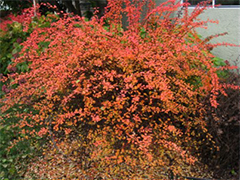INVASIVE PLANTS—WHY THEY MIGHT BE IMPORTANT TO YOU
 You have probably heard or read about the growing concern regarding invasive plants. Perhaps you’ve wondered how this problem affects you. The continued advancement of invasive species in New England not only affects the forest, but may have an effect on your physical health as well.
You have probably heard or read about the growing concern regarding invasive plants. Perhaps you’ve wondered how this problem affects you. The continued advancement of invasive species in New England not only affects the forest, but may have an effect on your physical health as well.
“Invasive plants, in my opinion, are probably my biggest concern when it comes to the proper management of forestland” states NEFCo forester Tony Lamberton. “The rapid spread of these invasives is phenomenal and over the long term will have a significant impact on how landowners will be able to manage their land” he adds.
While there are a number of invasive species to be concerned about, two species stand out as already being significant problems. They are Japanese Barberry and various species of Honeysuckle. Japanese Barberry was introduced in the United States as a landscape shrub in the 1860’s. Different cultivars have different size leaves and different color leaves. The red fruit persists well into the fall and winter months. Also, the plants respond very well to pruning, so this plant became a favorite of landscape designers. Shrub honeysuckles reproduce mainly by seed but some vegetative re-sprouting can occur in established populations. Plants mature between 3-5 years of age. Each plant produces thousands of berries as fruit, and each fruit contains 2-6 seeds. Seeds can remain viable for 3-5 years.
Shrub honeysuckles reproduce mainly by seed but some vegetative re-sprouting can occur in established populations. Plants mature between 3-5 years of age. Each plant produces thousands of berries as fruit, and each fruit contains 2-6 seeds. Seeds can remain viable for 3-5 years.
Sharing the characteristics of many of the invasives, barberry and honeysuckle can leave the landscaped garden where it was planted and take over the surrounding forests. It only takes one plant to create a whole colony if it is left uncontrolled. Because of the competitive advantage of the barberry and honeysuckle, the forests eventually have no new seedling trees, no native shrubs, and no spring wild flowers.
There are other serious consequences beyond the lack of native vegetation and biodiversity. One threat is the decrease in leaf litter, the decaying leaves found on the ground in most forests. This litter is really a protective layer over the soil. Loss of this protection is resulting in erosion problems. In addition to forestry issues, field experience by NEFCo foresters indicates that invasives tend to be where we run into significantly higher tick problems. In fact, studies by groups like the University of Connecticut Extension System are proving that an area over taken by Japanese Barberry provides a perfect habitat for the deer tick. They also provide a perfect habitat for mice which are secondary hosts for deer ticks. These are the ticks that can carry Lyme disease.
One study showed that in an uncontrolled barberry area, there were approximately 120 ticks per acre. In an area where the barberry was being controlled, there were 30 ticks per acre. In an area with no barberry, there were only 10 ticks per acres. That’s a 92% decrease in the deer tick population.
There are several methods that can be used to eradicate invasive species. Whether you try cutting them back or burning them back, you must continually monitor the regrowth. Managing the tick population on your property is surely an ongoing process; however, you can task these duties to your NEFCo professional. If herbicide application is determined to be a part of the plan, this procedure is best left to a professional such as the licensed herbicide applicators on the NEFCo staff. Contact your NEFCo representative for more information.

